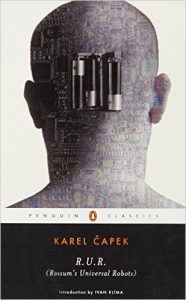Recently in history, artificial intelligence has been a big theory of concern among people. The concept of human-like robots is a new and unfamiliar idea and it has a tendency to make people uncomfortable. It has been an interesting experience to read and watch the different accounts of what people believe these creatures will be like in the future. We have gotten many different examples through different mediums and each one have been both unique, yet still similar in some ways to the other examples we have been studying. Throughout all of the works we have read in this class, there have been similarities and differences about the cybernetic bodies between each of the different mediums. The three different works I will be focusing on are the movie, Stepford Wives, the play R.U.R. and the television episode of Black Mirror.
In the movie, Stepford Wives, the women in the town of Stepford have all been replaced by the “ideal wife” the men in the town dreamt up. All of the women once they have been replaced with their robot counterpart are obedient, have the perfect, ideal body, genuinely enjoy household work such as cooking, cleaning, taking care of the children, and grocery shopping. The women do not have careers or jobs outside of the home and they are the paper definition of the “perfect woman”. The men in Stepford have clearly been working on the concept of creating the perfect wife for sometime and they have all of the means to do so. The men’s club is used to have the opportunity to draw perfect likenesses of the women to be used for the designing of the robots they also get a recording of the women’s voices to use. The fact that the men in this town see nothing wrong with killing and replacing their wives shocks me. Why would anyone want to give up the option of having a real conversation for someone who does the work of a maid but is still willing to have sex with them and please them in any way they can. The fact that this is what the movie suggests is all men care about speaks loud and clear.
In the episode from Black Mirror that we watched in class, the idea behind the intent for the cyborg is to aid in the grieving processes. This idea seems more humane than in Stepford Wives due to the fact that when Martha’s husband dies and she has been communicating with a computer program that used information about Ash, her deceased husband, she is fully aware the person is not real. And, when she reaches the point of the cyborg being introduced, she still knows he is not the real Ash, just an incredible likeness. Throughout the episode, the cyborg does or says things that upset Martha due to the fact the reaction was not what Ash would have actually said or done in that situation. This is different from the men in Stepford Wives because they wanted their wives to be obedient, they wanted them to change and be different which is why they killed and replaced them with cyborgs in the first place. However, Martha did not have a choice in the matter and if she had the option she would prefer the real Ash to the fake one who wishes to please her anyway she wishes. Both of the cyborgs in Stepford Wives and Black Mirror are obedient, they are lifelike and they can do anything their human version could do, they just do not have the thought processes of humans or the ability to react certain ways to things. For example, in Black Mirror, Martha becomes overwhelmed by the differences between cyborg Ash and the real man he was and she orders the cyborg to jump off of a cliff, Ash is willing to do so because it is what she asked of him. This upsets Martha more because she knows the real Ash would have fought her on it. In Stepford Wives, Joanna says that she bleeds when she cuts herself and asks Bobbie’s counterpart if she bleeds and stabs her in the stomach. Bobbie says, “Joanna, how could you do a thing like that?”(Katherine Ross and Paula Prentiss, 1975) and pulls the knife out of her stomach. Then Bobbie’s robot starts acting strange and repeating the same movements over and over, showing that her systems were malfunctioning.
In the play, R.U.R., the robots are very humanlike once again. When Helena first meets Sulla, she cannot believe that she is not human. In the play, Domin asks Sulla to let Helena have a look at her, “HELENA: (stands and offers her hand) Pleased to meet you. It must be very hard for you out here, cut off from the rest of the world.
SULLA: I do not know the rest of the world Miss Glory. Please sit down.
HELENA: (sits) Where are you from?
SULLA: From here, the factory.
HELENA: Oh, you were born here.
SULLA: Yes I was made here.
HELENA: (startled) What?
DOMIN: (laughing) Sulla isn’t a person, Miss Glory, she’s a robot.
HELENA: Oh, please forgive me…”(Capek, 1921). This encounter shows how these robots are much like the ones in both Stepford Wives, and the episode of Black Mirror we watched in class. The robots are also very content with being left to do their work. They do not seem to mind it too much, however, in the play, the robots realize they are sick of being ordered around and as a result they decide to kill every human on earth. They succeed in this plan as well, they manage to kill every human on earth, except one. They decide to let Alquist, the builder and chief of construction, live because, like them, he works with his hands. These robots are different in that they have thoughts and minds of their own and they use them to decide to kill the humans. In the end, Robot Helena and Robot Primus develop feelings toward one another and Alquist leaves the world to them knowing they will be the start of the next race on earth.
All in all, the robots tend to share a lot of the same characteristics between the different examples we have studied in class. The largest difference between the movie, play and episode would be that the robots in R.U.R. Revolt and kill the humans for the way they are treated. In Black Mirror and Stepford Wives, the robots do not seem like they would have the means to want to change the way they are, they know nothing else and are built in a way that they do not have minds of their own. The thought that one day these creatures could be considered the “norm” is an interesting concept to grasp. It is even more interesting to imagine which kind of cyborg they would most likely resemble. I think that, out of the three we’ve most recently looked at, the cyborgs from the episode of Black Mirror would be the kind I would want to see. The other two seem too odd for society. The damage that could be done from either one of those cyborgs is not something pleasant I would like to imagine.




